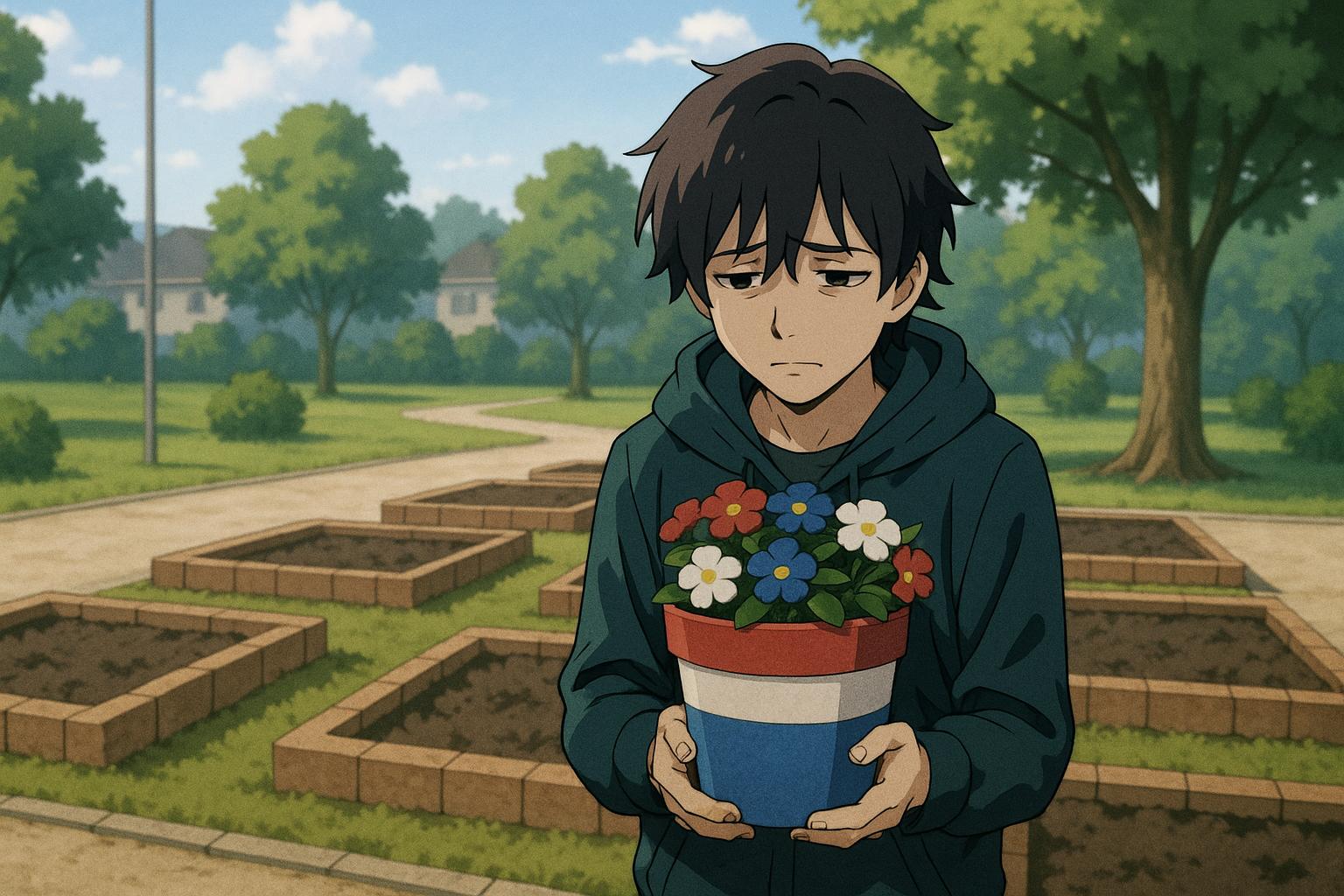Around 20 to 30 plants celebrating VE and VJ Day were stolen from Totton, Hampshire, prompting renewed concerns about community vandalism and the strain on local resources to maintain public spaces. This latest theft echoes similar incidents nationwide, highlighting a troubling pattern of targeting symbols of remembrance and neighbourhood pride.
In a troubling incident in Totton, Hampshire, local authorities have reported the theft of approximately 20 to 30 plants, predominantly in red, white, and blue, which were installed to commemorate VE Day and VJ Day. Occurring between May 27 and May 29, the theft not only impacts the visual appeal of the town but also represents a deeper betrayal of community spirit. Councillor David Harrison described the act as “selfish” and highlighted the burden it places on local resources. He noted that the council already allocates significant funds to combat vandalism and theft, asserting, “These latest crimes against the community are particularly hard to swallow.”
The council has expressed disappointment, stating that the theft is a substantial loss not only to the community but to the image of Totton itself. They further indicated that the current economic climate, marked by rising costs and high demand for plants, may prevent them from replacing the stolen items. A spokesperson for Totton and Eling Town Council, speaking on behalf of the community, lamented the frequency of such incidents, stating, “Although this is not the first time we have experienced plant thefts, what has been removed on this occasion is considerable.”
This incident is not isolated; similar thefts have been reported across the UK, indicating a worrying trend. In June 2024, 55 box plants were stolen from a war memorial in Royal Wootton Bassett, just ahead of the 80th anniversary of D-Day. Mayor Pat Farrow condemned this act as a desecration of an important site, emphasizing the profound emotional impact such thefts have on local communities. In many cases, community members have rallied to replace stolen items, as seen in Wiltshire, where local businesses funded new plants to restore the memorial in time for Remembrance Sunday.
In Totton itself, history has shown a pattern of targeting community initiatives. Earlier this year, vandalism saw the Eling Boardwalk damaged, leaving it impossible for pedestrians to use. Such destructive behaviours appear to provoke reactions from local councils and residents, though Councillor Harrison suggests that the motivations behind these petty crimes remain largely unaddressed. “Every generation seems to have a minority of individuals who vandalise property,” he remarked, reflecting a sense of frustration that prevails among those dedicated to enhancing the local environment.
Moreover, community gardens and enhancement projects in various regions, such as a recent incident in Fife where all plants were stolen from a community garden, further highlight the emotional toll of these violations. Volunteers, who invest significant time and effort in creating spaces for communal enjoyment and support, often find their work undone by the actions of a few. Centre manager Mandy Hunter noted the absence of vandalism at her facility, suggesting a coordinated effort to steal rather than random acts of destruction.
In Glasgow, a similar narrative unfolded earlier this year when members of the Love Thornwood group discovered that around 20 of their plants, part of a biodiversity project, had been stolen. Group founder Shaun Conroy expressed his deep disappointment over the thefts, which undermine community spirit and the hard work of residents aiming to enrich their urban environment.
As Totton and Eling Town Council continues to grapple with these recurring challenges, they urge the community to report any suspicious behaviour in hope of deterring future thefts. The collective frustration within these communities reflects a broader concern about the protection of public spaces and the need for cohesive action to combat the pervasive problem of theft and vandalism.
Reference Map:
Source: Noah Wire Services
- https://www.dailyecho.co.uk/news/25204468.totton-centre-plants-commemorating-ve-vj-day-stolen/ – Please view link – unable to able to access data
- https://www.bbc.co.uk/news/articles/cv22y9y3jq8o – In June 2024, 55 box plants were stolen from the path leading to the war memorial in Royal Wootton Bassett, Wiltshire. The theft occurred over the weekend of 15-16 June, just before the 80th anniversary of D-Day. Mayor Pat Farrow expressed shock and sadness over the incident, describing it as a desecration of the memorial. Wiltshire Police investigated the theft, and local businesses later funded the replacement of the stolen plants in time for Remembrance Sunday.
- https://www.advertiserandtimes.co.uk/news/bird-boxes-and-bug-hotels-decorated-by-children-stolen-from-9244915/ – Between 23 February and 9 March 2022, eight bug hotels and six bird boxes, decorated by local children, were stolen from Bartley Park near Totton. The items were installed by the Friends of Bartley Park, a group dedicated to maintaining the area. The theft was reported to the police, and a spokesperson urged anyone with information to come forward, highlighting the uniqueness and sentimental value of the stolen items.
- https://www.thecourier.co.uk/fp/news/fife/2136814/volunteers-deeply-upset-after-callous-thieves-steal-plants-from-fife-support-centre/ – Between 11 and 12 April 2024, thieves stole all the plants from the community garden at Linton Lane Community Centre in Kirkcaldy, Fife. The theft left volunteers upset and angry, as the garden was a recent addition to support the local community. Centre manager Mandy Hunter expressed her disappointment, noting the absence of any signs of vandalism, suggesting the plants were intentionally stolen. Local residents and businesses later donated replacement plants to restore the garden.
- https://www.glasgowtimes.co.uk/news/scottish-news/20617987.its-disappointing-glasgow-group-hits-community-grown-plants-stolen/ – In May 2024, members of the Love Thornwood group in Glasgow discovered that around 20 plants, part of their ‘Thornwood in Bloom’ project, had been stolen from Dumbarton Road. The initiative aimed to enhance biodiversity and beautify the area. Founder Shaun Conroy expressed disappointment over the thefts, noting the plants were easily dug up, and mentioned a previous incident where a recycled wheelbarrow was stolen. The group planned to create signs to inform the public about the project and deter future thefts.
- https://www.dailyecho.co.uk/news/18917059.fury-theft-christmas-lights-equipment-totton/ – In December 2024, thieves stole electrical cables from the Christmas lights equipment in Totton, Hampshire, for the second consecutive year. Volunteers from the town’s Christmas lights committee discovered the theft while checking fixtures on the main roundabout. Councillor Neville Penman expressed frustration over the incident, noting the need to purchase new cables, lights, and fittings. The theft was condemned on social media, with residents expressing disbelief over the act during a challenging year.
- https://www.bbc.com/news/articles/c722glxlg2eo – In June 2024, drivers in Totton, Hampshire, were warned about thieves placing cones and barriers on Jacobs Gutter Lane to steal vehicles. A Ford Focus was stolen early on a Sunday after the driver stopped to move the obstructions. The vehicle was later recovered. Hampshire and Isle of Wight Constabulary investigated the incidents and increased patrols in the area to deter further thefts.













